A Survey on the Evolution of Opportunistic Routing with Asynchronous Duty-Cycled MAC in Wireless Sensor Networks
Abstract
1. Introduction
2. Related Studies
- We highlight the main reasons behind energy drainage while applying asynchronous duty-cycled MAC functionalities to opportunistic routing protocols in WSNs;
- We have provided a review of the asynchronous duty-cycled MAC protocols that have been proposed up until the present time, and explain their data transmission procedure with an illustrative diagram. We have also discussed their main contributions and limitations regarding energy consumption;
- We have presented a literature review of opportunistic routing protocols and their evaluation, while explaining their base MAC mechanisms;
- We have focused on energy consumption, and have analyzed and compared the OR protocols based on their addressed challenges, deployed networks, base MAC functionalities, decision metrics, advantages and disadvantages.
3. Opportunistic Routing Protocol in WSNs
3.1. Concept of Opportunistic Routing in WSNs
- Selecting a prospective group of forwarders;
- Broadcasting data packets to the selected forwarders;
- Finalizing a unique forwarder using a coordination system;
- Forwarding the packet.
3.2. Concept of MAC Protocol for Maintaining Duty Cycle
- Nodes periodically enter into a sleep mode (periodic listening and sleeping);
- Neighbor nodes compose a virtual cluster in order to auto-synchronize in the sleep schedule (collision and overhearing avoidance);
- Apply ‘message passing’ to reduce contention latency for sensor network applications that require store-and-forward processing as data move through the network.
4. Issues of Opportunistic Routing in Asynchronous WSN
4.1. Multiple Sender
4.2. Multiple Receiver
4.3. Dynamic Route Selection
4.4. Data Redundancy
4.5. Control Packet Overhead
4.6. Sender Waiting Time
4.7. Receiver Waiting Time
4.8. Hidden Terminal Problem
4.9. Forwarder Cooperation
5. Evolution of Opportunistic Routing in Asynchronous WSN
5.1. Evolution of Asynchronous Duty-Cycled MAC Protocols
5.1.1. B-MAC
5.1.2. Wise-MAC
5.1.3. X-MAC
5.1.4. BoX-MAC
5.1.5. RI-MAC
5.1.6. DCM-MAC
5.1.7. PW-MAC
5.1.8. MiC-MAC
5.1.9. RIX-MAC
5.1.10. TRIX-MAC
5.2. Evolution of Opportunistic Routing Protocols
5.2.1. ORW
5.2.2. ORD
5.2.3. ORR
5.2.4. MOR
5.2.5. MORR
5.2.6. LORA
5.2.7. LEOR
5.3. Applications of Opportunistic Routing Protocols
5.3.1. ODCR
5.3.2. AMOR
6. Comparison Analysis and Research Challenges
6.1. Comparison Analysis
6.2. Research Challenges
6.2.1. Multiple Sender
6.2.2. Multiple Receiver
6.2.3. Dynamic Route Selection
6.2.4. Data Redundancy
6.2.5. Control Packet Overhead
6.2.6. Sender Waiting Time
6.2.7. Receiver Waiting Time
6.2.8. Hidden Terminal Problem
6.2.9. Forwarder Cooperation
7. Conclusions
Author Contributions
Funding
Conflicts of Interest
References
- Ye, W.; Heidemann, J.; Estrin, D. An energy-efficient MAC protocol for wireless sensor networks. In Proceedings of the Twenty-First Annual Joint Conference of the IEEE Computer and Communications Societies, New York, NY, USA, 23–27 June 2002; Volume 3, pp. 1567–1576. [Google Scholar] [CrossRef]
- Han, K.; Luo, J.; Liu, Y.; Vasilakos, A.V. Algorithm design for data communications in duty-cycled wireless sensor networks: A survey. IEEE Commun. Mag. 2013, 51, 107–113. [Google Scholar] [CrossRef]
- Sharma, M.; Singh, Y.; Kumar, N. Opportunistic Routing in Wireless Sensor Networks: A Comparative Analysis. J. Basic Appl. Eng. Res. 2014, 1, 94–98. [Google Scholar]
- Biswas, S.; Morris, R. ExOR: Opportunistic Multi-Hop Routing for Wireless Networks. In Proceedings of the 2005 Conference on Applications, Technologies, Architectures and Protocols for Computer Communications, Philadelphia, PA, USA, 22–26 August 2005; pp. 133–144. [Google Scholar] [CrossRef]
- Zhong, Z.; Wang, J.; Lu, G.; Nelakuditi, S. On Selection of Candidates for Opportunistic Any-Path Forwarding. ACM SIGMOBILE Mob. Comput. Commun. Rev. 2006, 10, 1–2. [Google Scholar] [CrossRef]
- Chachulski, S.; Jennings, M.; Katti, S.; Katabi, D. Trading Structure for Randomness in Wireless Opportunistic Routing. In Proceedings of the 2007 Conference on Applications, Technologies, Architectures and Protocols for Computer Communications (SIGCOMM’07), Kyoto, Japan, 27–31 August 2007; Volume 37, p. 169. [Google Scholar] [CrossRef]
- Zeng, K.; Lou, W.; Yang, J.; Iii, D.R.B. On Throughput Efficiency of Geographic Opportunistic Routing in Multihop Wireless Networks. In Proceedings of the 4th International ICST Conference on Heterogeneous Networking for Quality, Reliability, Security and Robustness, Vancouver, BC, Canada, 14–17 August 2007. [Google Scholar] [CrossRef]
- Rozner, E.; Seshadri, J.; Mehta, Y.; Qiu, L. SOAR: Simple opportunistic adaptive routing protocol for wireless mesh networks. IEEE Trans. Mob. Comput. 2009, 8, 1622–1635. [Google Scholar] [CrossRef]
- Hung, M.C.C.; Lin, K.C.J.; Chou, C.F.; Hsu, C.C. EFFORT: Energy-efficient opportunistic routing technology in wireless sensor networks. Wirel. Commun. Mob. Comput. 2013, 13, 760–773. [Google Scholar] [CrossRef]
- Zhang, X.; Li, B. Optimized Multipath Network Coding in Lossy Wireless Networks. In Proceedings of the 28th International Conference on Distributed Computing Systems, Beijing, China, 17–20 June 2008; Volume 27, pp. 622–634. [Google Scholar] [CrossRef]
- Landsiedel, O.; Ghadimi, E.; Duquennoy, S.; Johansson, M. Low power, low delay: Opportunistic routing meets duty cycling. In Proceedings of the ACM/IEEE 11th International Conference on Information Processing in Sensor Networks (IPSN), Beijing, China, 16–19 April 2012; pp. 185–196. [Google Scholar] [CrossRef]
- So, J.; Byun, H. Opportunistic routing with in-network aggregation for duty-cycled WSNs with delay requirements. EURASIP J. Wirel. Commun. Netw. 2014, 1, 1–16. [Google Scholar] [CrossRef]
- So, J.; Byun, H. Load-Balanced Opportunistic Routing for Duty-Cycled Wireless Sensor Networks. IEEE Trans. Mob. Comput. 2017, 16, 1940–1955. [Google Scholar] [CrossRef]
- Zhang, P.; Landsiedel, O.; Theel, O.E. MOR: Multichannel Opportunistic Routing for Wireless Sensor Networks. In Proceedings of the International Conference on Embedded Wireless Systems and Networks (EWSN’17), Uppsala, Sweden, 20–22 February 2017; pp. 36–47. [Google Scholar] [CrossRef]
- Khan, A.; Javaid, N.; Sher, A.; Abbasi, R.A.; Ahmad, Z.; Ahmed, W. Load Balancing and Collision Avoidance using Opportunistic Routing in Wireless Sensor Networks. In Proceedings of the 2018 IEEE 32nd International Conference on Advanced Information Networking and Applications (AINA), Krakow, Poland, 16–18 May 2018; pp. 236–243. [Google Scholar] [CrossRef]
- Hawbani, A.; Wang, X.; Sharabi, Y.; Ghannami, A.; Kuhlani, H.; Karmoshi, S. LORA: Load-Balanced Opportunistic Routing for Asynchronous Duty-Cycled WSN. IEEE Trans. Mob. Comput. 2019, 18, 1601–1615. [Google Scholar] [CrossRef]
- Abedi, O.; Somayeh, R.K. Load-balanced and energy-aware opportunistic routing with adaptive duty cycling for multi-channel WSNs. J. Supercomput. 2020. [Google Scholar] [CrossRef]
- Chakchouk, N. A Survey on Opportunistic Routing in Wireless Communication Networks. IEEE Commun. Surv. Tutor. 2015, 17, 2214–2241. [Google Scholar] [CrossRef]
- Jadhav, P.; Satao, R. A Survey on Opportunistic Routing Protocols for Wireless Sensor Networks. Procedia Comput. Sci. 2016, 79, 603–609. [Google Scholar] [CrossRef]
- Nithya, R.; Mahendran, N. A SURVEY: Duty cycle Based Routing and Scheduling in Wireless Sensor Networks. In Proceedings of the 2015 2nd International Conference on Electronics and Communication Systems (ICECS), Coimbatore, India, 26–27 February 2015; pp. 813–817. [Google Scholar] [CrossRef]
- Patel, T.; Kamboj, P. Opportunistic routing in wireless sensor networks: A review. In Proceedings of the IEEE International Advance Computing Conference (IACC), Banglore, India, 12–13 June 2015; pp. 983–987. [Google Scholar] [CrossRef]
- Yahya, B.; Ben-Othman, J. Towards a classification of energy aware MAC protocols for wireless sensor networks. Wirel. Commun. Mob. Comput. 2009, 9, 1572–1607. [Google Scholar] [CrossRef]
- Bachir, A.; Dohler, M.; Watteyne, T.; Leung, K.K. MAC Essentials for Wireless Sensor Networks. IEEE Commun. Surv. Tutor. 2010, 12, 222–248. [Google Scholar] [CrossRef]
- Huang, P.; Xiao, L.; Soltani, S.; Mutka, M.W.; Xi, N. The Evolution of MAC Protocols in Wireless Sensor Networks: A Survey. IEEE Commun. Surv. Tutor. 2013, 15, 101–120. [Google Scholar] [CrossRef]
- Kakria, A.; Aseri, T.C. A Survey on Asynchronous MAC protocols in Wireless Sensor Networks. Int. J. Comput. Appl. 2014, 108, 19–22. [Google Scholar] [CrossRef]
- Alfayez, F.; Hammoudeh, M.; Abuarqoub, A. A survey on MAC protocols for duty-cycled wireless sensor networks. In Proceedings of the International Conference on Advanced Wireless, Information and Communication Technologies (AWICT 2015), Tunis, Tunisia, 5–7 October 2015; Volume 73, pp. 482–489. [Google Scholar] [CrossRef]
- Anubhama, R.; Rajendran, T. A Survey on Mac Protocols for Wireless Sensor Networks. In Proceedings of the Second International Conference on Research in Intelligent and Computing in Engineering, Gopeshwar, Uttrakhand, India, 24–26 March 2017; Volume 10, pp. 121–126. [Google Scholar] [CrossRef]
- Polastre, J.; Hill, J.; Culler, D. Versatile low power media access for wireless sensor networks. In Proceedings of the 2nd International Conference on Embedded Networked Sensor Systems (SenSys’04), Baltimore, MD, USA, 3–5 November 2004; pp. 95–107. [Google Scholar] [CrossRef]
- El-hoiydi, A.; Decotignie, J. WiseMAC: An Ultra Low Power MAC Protocol for Multi-hop Wireless Sensor Networks. In Algorithmic Aspects of Wireless Sensor Networks. ALGOSENSORS 2004. Lecture Notes in Computer Science; Nikoletseas, S.E., Rolim, J.D.P., Eds.; Springer: Berlin/Heidelberg, Germany, 2004; Volume 3121, pp. 18–31. [Google Scholar] [CrossRef]
- Buettner, M.; Yee, G.V.; Anderson, E.; Han, R. X-MAC: A Short Preamble MAC Protocol for Duty-Cycled Wireless Sensor Networks. In Proceedings of the 4th International Conference on Embedded Networked Sensor Systems (SenSys’06), Boulder, CO, USA, 31 October–3 November 2006; pp. 307–320. [Google Scholar] [CrossRef]
- Moss, D.; Levis, P. BoX-MACs: Exploiting Physical and Link Layer Boundaries in Low-Power Networking; Technical Report SING-08-00; Stanford University: Stanford, CA, USA, 2008. [Google Scholar]
- Sun, Y.; Johnson, D.B. RI-MAC: A Receiver-Initiated Asynchronous Duty Cycle MAC Protocol for Dynamic Traffic Loads in Wireless Sensor Networks. In Proceedings of the 6th ACM Conference on Embedded Network Sensor Systems (SenSys’08), Raleigh, NC, USA, 5–7 November 2008; pp. 1–14. [Google Scholar] [CrossRef]
- Li, J.; Desheng, Z.; Longjiang, G. DCM: A duty cycle based multi-channel MAC protocol for wireless sensor networks. In Proceedings of the IET International Conference on Wireless Sensor Network 2010 (IET-WSN 2010), Beijing, China, 15–17 November 2010; pp. 233–238. [Google Scholar] [CrossRef]
- Johnson, D.B. PW-MAC: An Energy-Efficient Predictive-Wakeup MAC Protocol for Wireless Sensor Networks. In Proceedings of the 2011 IEEE INFOCOM, Shanghai, China, 10–15 April 2011; pp. 1305–1313. [Google Scholar] [CrossRef]
- Nahas, A.B.; Duquennoy, S.; Iyer, V.; Voigt, T. Low-power listening goes multi-channel. In Proceedings of the 2014 IEEE International Conference on Distributed Computing in Sensor Systems, Marina Del Rey, CA, USA, 26–28 May 2014; pp. 2–9. [Google Scholar] [CrossRef]
- Park, I.; Lee, H.; Kang, S. RIX-MAC: An Energy-Efficient Receiver-Initiated Wakeup MAC Protocol for WSNs. KSII Trans. Internet Inf. Syst. 2014, 8, 1604–1617. [Google Scholar] [CrossRef]
- Lee, H. Performance of a Receiver-initiated X-MAC Protocol for Tree-based Wireless Sensor Networks. In Proceedings of the 2018 International Conference on Computational Science and Computational Intelligence (CSCI), Las Vegas, NV, USA, 13–15 December 2018; pp. 806–809. [Google Scholar] [CrossRef]
- Hamada, L.; Henna, S. AS-PW-MAC: An adaptive scheduling predictive wake-up MAC protocol for wireless sensor networks. In Proceedings of the Conference: 2016 Sixth International Conference on Innovative Computing Technology (INTECH), Dublin, Ireland, 24–26 August 2016; pp. 525–530. [Google Scholar] [CrossRef]
- Dong, C.; Yu, F. A prediction-based asynchronous MAC protocol for heavy traffic load in wireless sensor networks. AEU-Int. J. Electron. Commun. 2017, 82, 241–250. [Google Scholar] [CrossRef]
- Nguyen, V.T.; Gautier, M.; Berder, O. Implementation of an adaptive energy-efficient MAC protocol in OMNeT++/MiXiM. arXiv 2014, arXiv:1409.0991. [Google Scholar]
- Alam, M.M.; Ben-Hamida, E.; Berder, O.; Menard, D.; Sentieys, O. A Heuristic Self-Adaptive Medium Access Control for Resource-Constrained WBAN Systems. IEEE Access 2016, 4, 1287–1300. [Google Scholar] [CrossRef]
- Zhang, D.G.; Zhou, S.; Tang, Y.M. A Low Duty Cycle Efficient MAC Protocol Based on Self-Adaption and Predictive Strategy. Mob. Netw. Appl. 2017, 23, 828–839. [Google Scholar] [CrossRef]
- Fujimoto, A.; Masui, Y.; Yoshihiro, T. Scheduling Beacon Transmission to Improve Delay for Receiver-initiated-MAC Based Wireless Sensor Networks. J. Inf. Process. 2018, 26, 140–147. [Google Scholar] [CrossRef][Green Version]
- Wymore, M.L.; Qiao, D. RIVER-MAC: A Receiver-initiated asynchronously duty-cycled MAC protocol for the internet of things. In Proceedings of the 2019 IEEE 43rd Annual Computer Software and Applications Conference (COMPSAC), Milwaukee, WI, USA, 15–19 July 2019; Volume 1, pp. 860–869. [Google Scholar] [CrossRef]
- Zhang, X.; Tao, L.; Yan, F.; Sung, D.K. Shortest-Latency Opportunistic Routing in Asynchronous Wireless Sensor Networks with Independent Duty-Cycling. IEEE Trans. Mob. Comput. 2020, 19, 711–723. [Google Scholar] [CrossRef]
- Kim, T.; Lee, H. Performance Evaluation of the RIX-MAC Protocol for Wireless Sensor Networks. KSII Trans. Internet Inf. Syst. 2017, 11, 764–784. [Google Scholar] [CrossRef]
- Lee, H.; Lee, H. Modeling and Analysis of an Energy-efficient MAC Protocol for Wireless Sensor Networks. In Proceedings of the 2016 International Conference on Information Networking (ICOIN), Kota Kinabalu, Malaysia, 13–15 January 2016; pp. 402–405. [Google Scholar] [CrossRef]
- Kakria, A.; Aseri, T.C. Survey of synchronous MAC protocols for Wireless Sensor Networks. In Proceedings of the 2014 Recent Advances in Engineering and Computational Sciences (RAECS), Chandigarh, India, 6–8 March 2014; pp. 1–4. [Google Scholar] [CrossRef]
- Kabara, J.; Calle, M. MAC Protocols Used by Wireless Sensor Networks and a General Method of Performance Evaluation. Int. J. Distrib. Sens. Netw. 2012, 8, 834784. [Google Scholar] [CrossRef]
- Jain, R. Performance Evaluation of Wireless MAC Protocols Do Ambient Noise, Throughput, or Protocol Affect Energy Consumption, Latency, or Reliability of a Wireless Sensor Network. 2013, pp. 1–19. Available online: https://www.cse.wustl.edu/~jain/cse567-13/ftp/mac/index.html (accessed on 24 April 2013).
- Dunkels, A. The ContikiMAC Radio Duty Cycling Protocol; Tech. Rep. urn:nbn:se:ri:diva-22724; Swedish Institute of Computer Science: Kista, Sweden, 2011. [Google Scholar]
- Siraj, M. A Survey on Routing Algorithms and Routing Metrics for Wireless Mesh Networks. World Appl. Sci. J. 2014, 30, 870–886. [Google Scholar] [CrossRef]
- Quy, V.K.; Ban, N.T.; Nam, V.H.; Tuan, D.M.; Han, N.D. Survey of recent routing metrics and protocols for mobile Ad-hoc networks. J. Commun. 2019, 14, 110–120. [Google Scholar] [CrossRef]
- Ghadimi, E.; Landsiedel, O.; Soldati, P.; Duquennoy, S.; Johansson, M. Opportunistic routing in low duty-cycle wireless sensor networks. ACM Trans. Sens. Netw. 2014, 10, 1–39. [Google Scholar] [CrossRef]
- Al-kahtani, M.S.; Karim, L.; Khan, N. Efficient Opportunistic Routing Protocol for Sensor Network in Emergency Applications. Electronics 2020, 9, 455. [Google Scholar] [CrossRef]
- Zhang, Q.; Song, Y.; Sun, B.; Dai, Z. Design of Routing Protocol for Opportunistic Network Based on Adaptive Motion. IEEE Access 2020, 8, 18228–18239. [Google Scholar] [CrossRef]
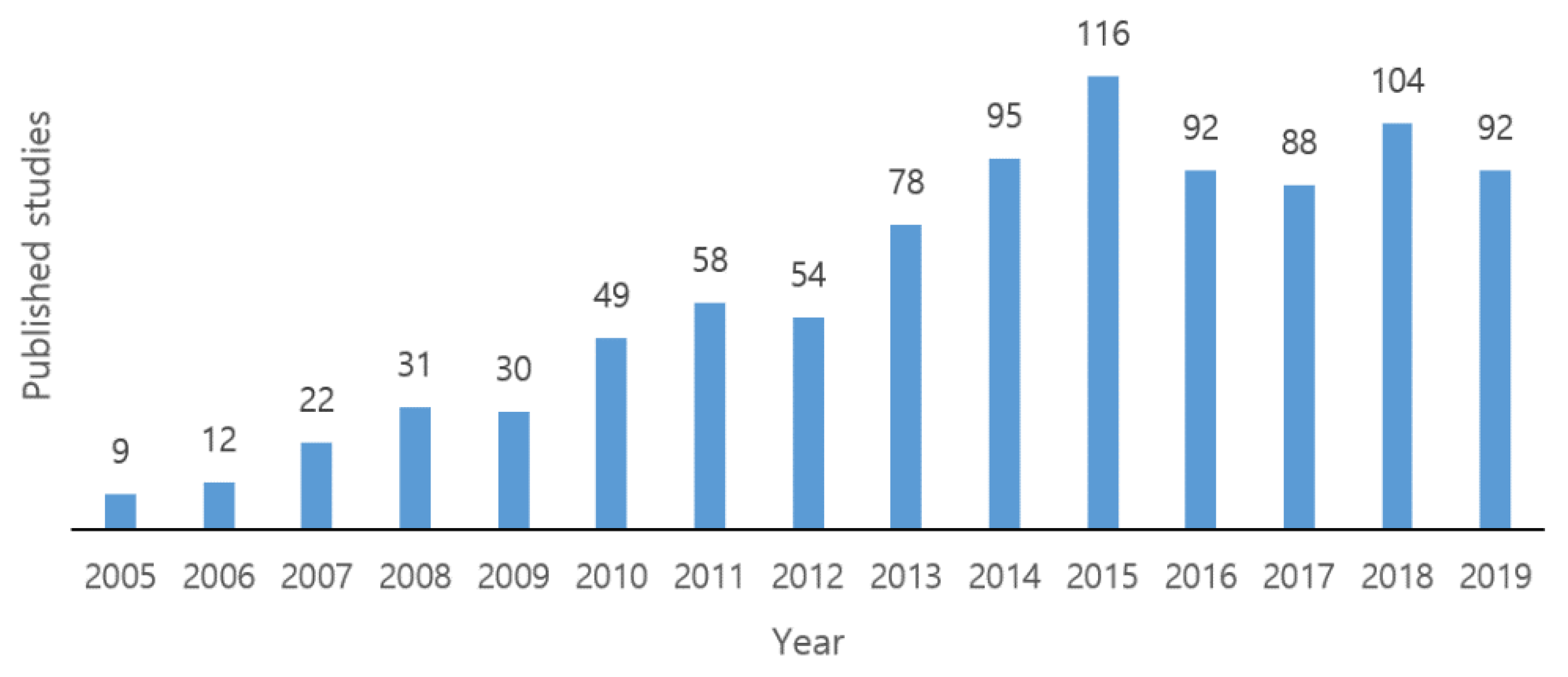
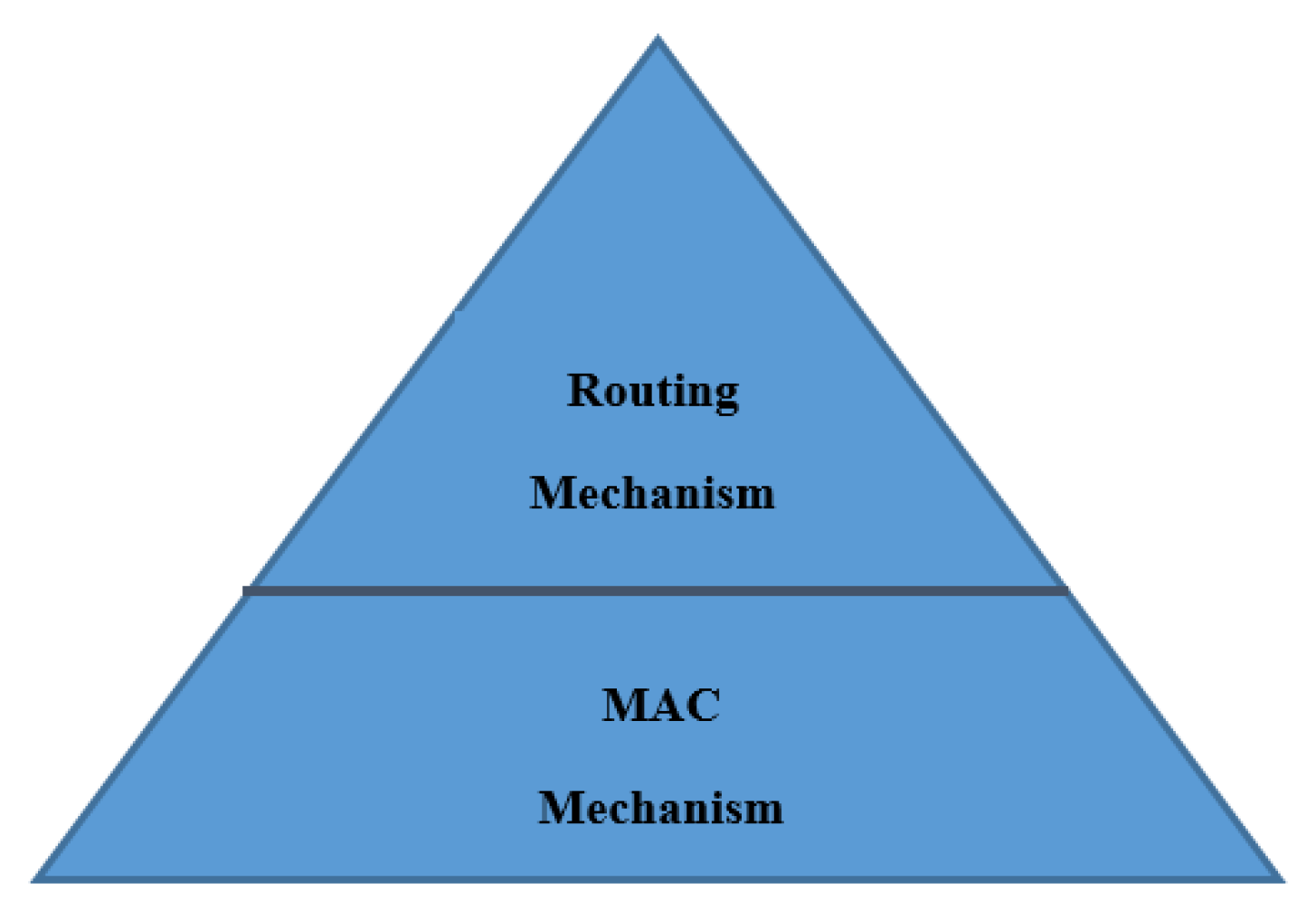








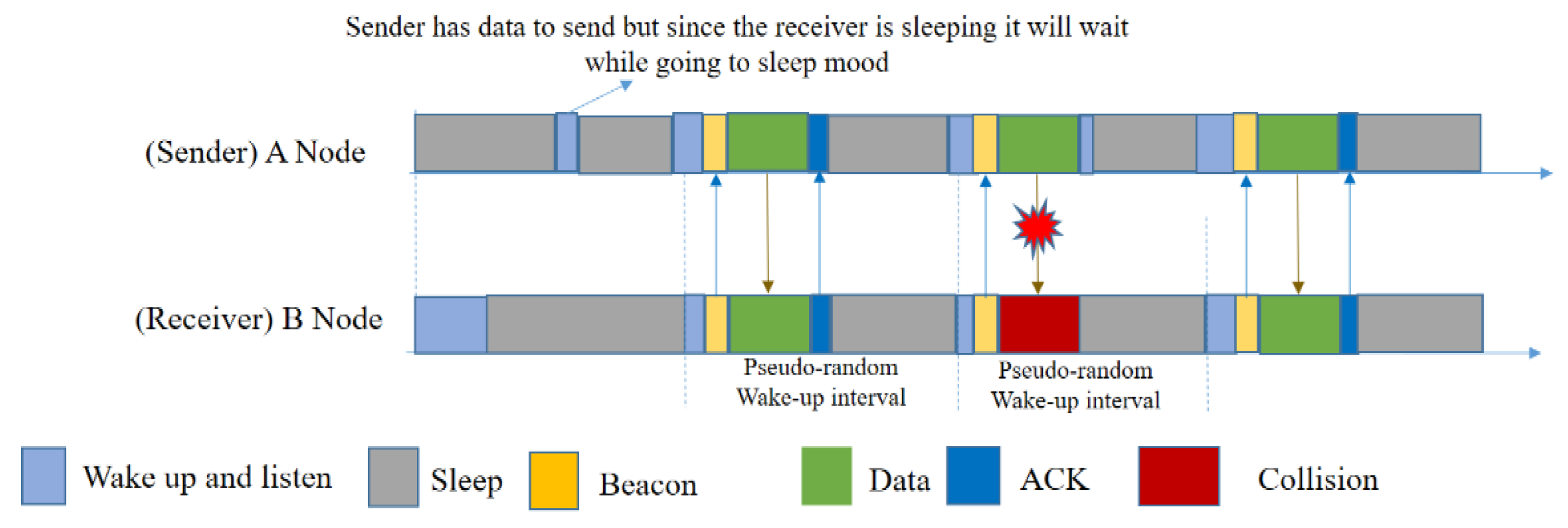
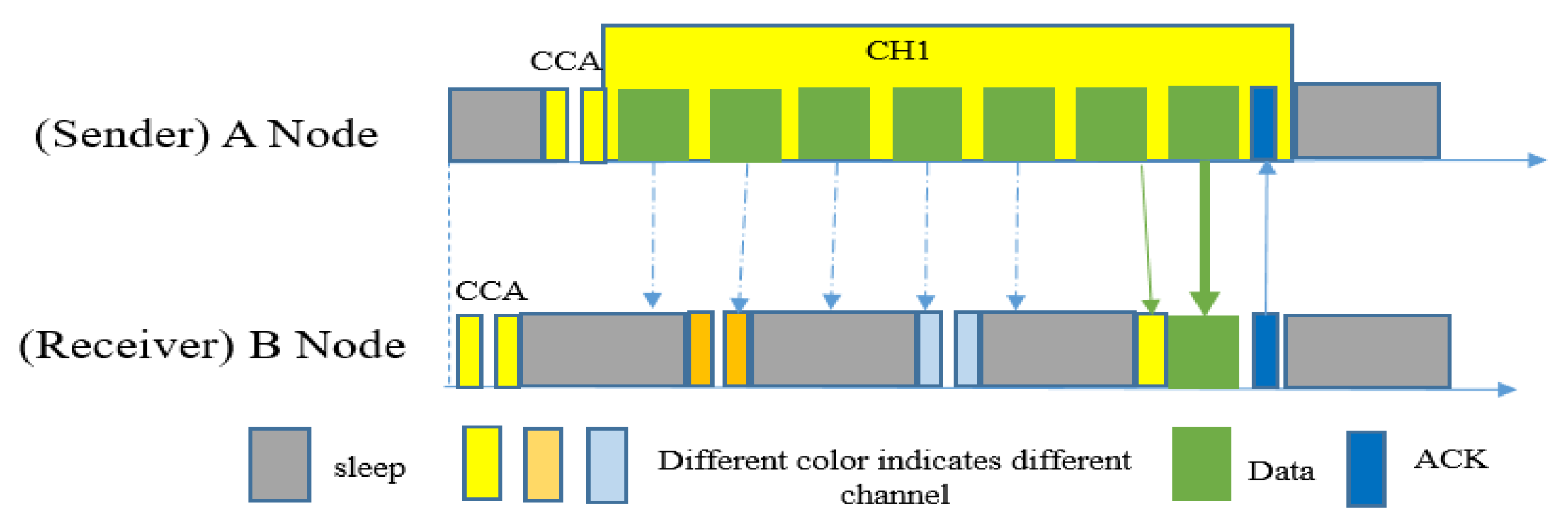




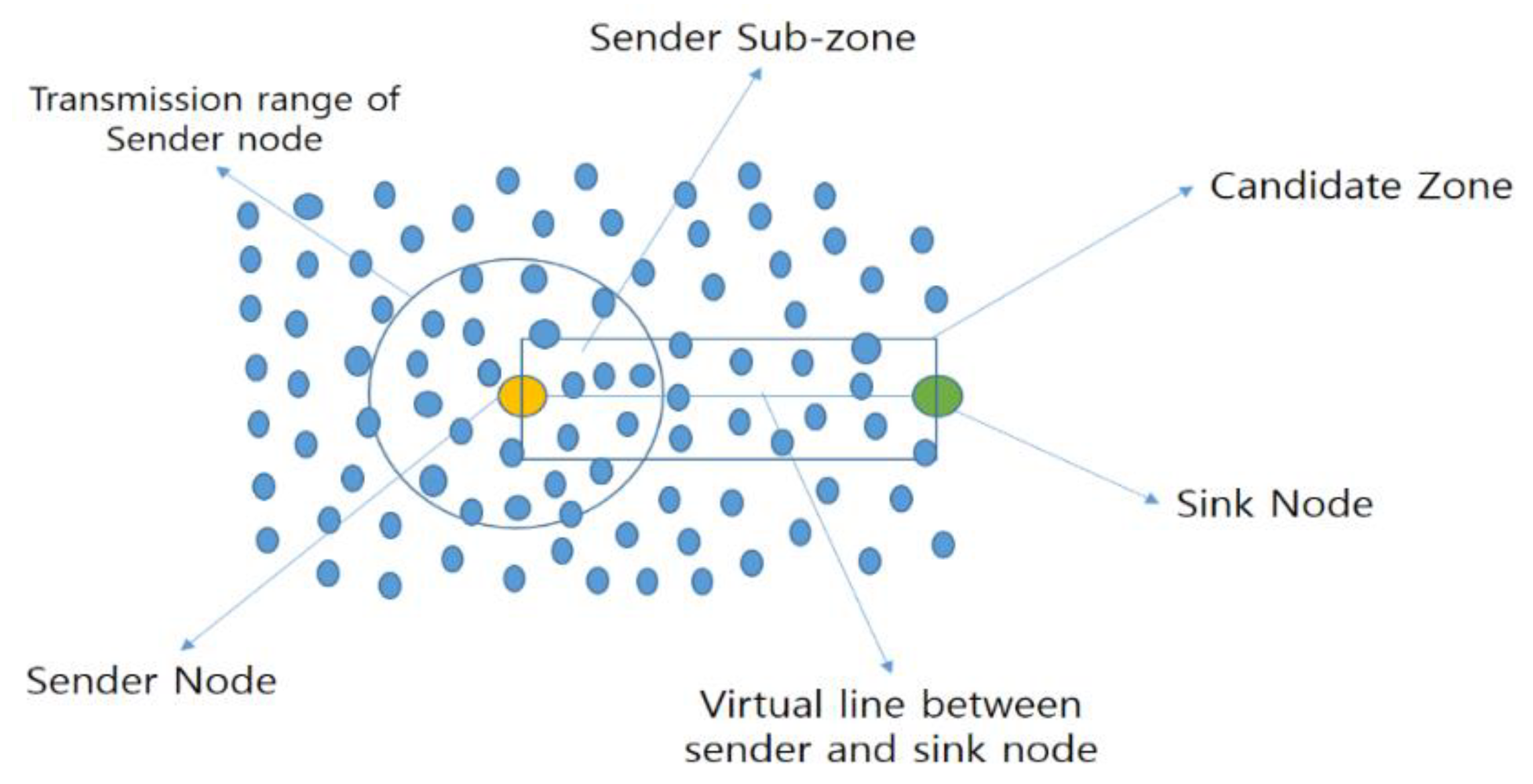
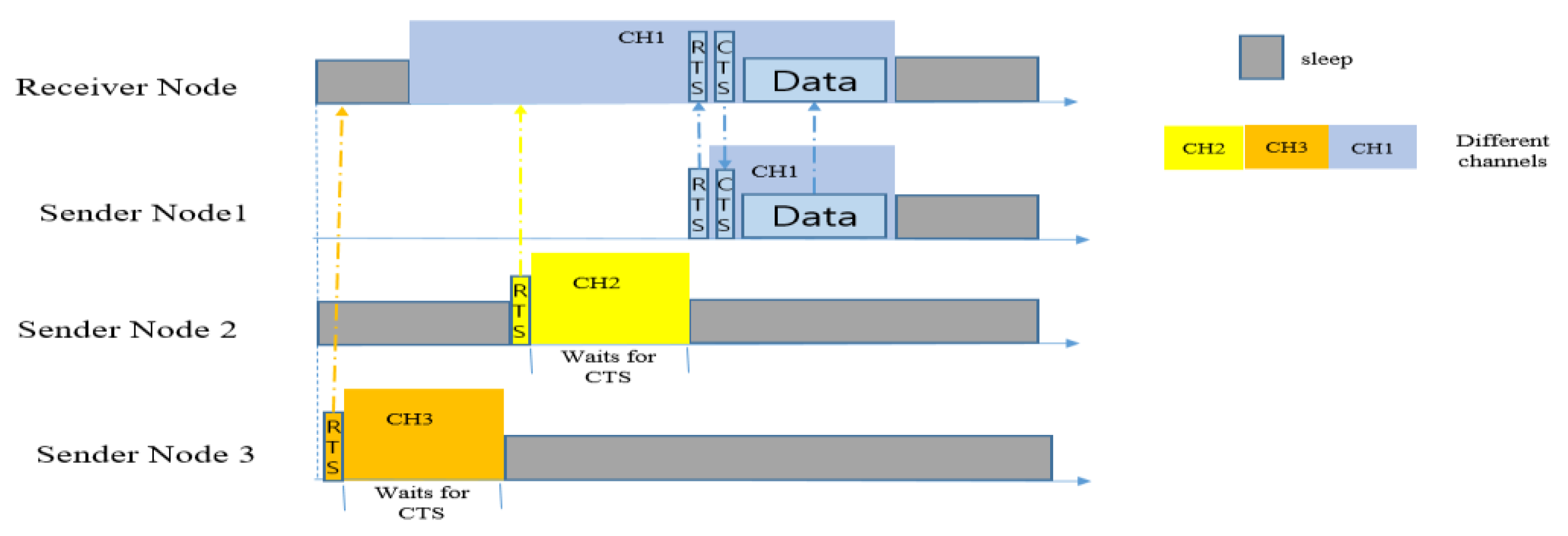
| Papers | Survey Criteria | OR Protocols | ADCM Protocols | Partial Comparisons | Description |
|---|---|---|---|---|---|
| Ref. [18] 2015 | Routing objectives, approaches, optimization tools. | √ | X | √ | Provided a comparative analysis that can give a clear view of the main features of the protocols and their contributions |
| Ref. [19] 2016 | Performance of OR in different types of wireless networks. | √ | X | √ | Evaluate the performance of opportunistic routing protocols in other communication networks |
| Ref. [20] 2015 | Various sleep–wake scheduling schemes with routing. | √ | X | √ | Describes various scheduling schemes with routing and their performance in a wireless sensor network |
| Ref. [21] 2015 | Candidate selection processes and coordination schemes in OR. | √ | X | √ | Focused on the issue of reducing retransmission in order to prevent unnecessary energy consumption |
| Ref. [3] 2014 | Overall routing issues of WSN. | √ | X | √ | Focused on all WSN issues and discussed the contribution of the opportunistic routing protocol to these issues |
| Ref. [22] 2009 | Underlying access techniques of MAC protocols. | X | √ | √ | Focused on the energy efficiency, latency and throughput factors of WSNs and discussed the open research issues |
| Ref. [23] 2010 | Issues of WSN related to MAC protocols. | X | √ | √ | Explained the MAC protocol functionalities in order to solve the WSN issues and pointed out hardware factors of the protocols |
| Ref. [24] 2013 | Time management and the sender and receiver waiting time in MAC. | X | √ | X | Classified the protocols and explained the course of motivation that drove the evaluation of the protocols |
| Ref. [25] 2014 | Energy consumption factors of WSN MAC. | X | √ | X | Explained how sensor nodes communicate with each other using their mismatched duty cycles in each MAC protocol |
| Ref. [26] 2015 | Mode of operation in synchronous and asynchronous MAC. | X | √ | √ | Examined the protocols’ performances considering a linear/chain-type WSN |
| Ref. [27] 2017 | Throughput, efficiency, stability, fairness, low access delay, low transmission delay and low overhead. | X | √ | √ | Presented the study of various WSN-specific MAC protocols based on various design factors |
| Our Survey | Unnecessary power consumption and load balancing factors of OR with ADCM in WSN | √ | √ | √ | Based on load-balancing factors provided reviews on the evolution of ADCM and OR protocols and pointed out the issues while using both protocols together in WSN |
| ORPA | Published Timeline | Addressed Issues | Routing Metric | Advantages | Drawbacks | Network | DC | Base MAC |
|---|---|---|---|---|---|---|---|---|
| ORW [11] | 2012 | Sender waiting time, multiple receivers, forwarder cooperation | EDC, PRR | Introduced new routing metric EDC; mechanism for choosing unique forwarders, increased throughput, decreased latency and energy consumption, flexible to link dynamics and changes. | Recursive calculation cost, ignores load-balancing issue, high control overhead, only topology change triggers recalculation of forwarder set. | Sparse to Dense (100~1000) | Asynchronous | BoX-MAC |
| ORD [12] | 2014 | Sender waiting time, energy consumption, number of transmissions, latency | EDC, Residual energy of each node, Hop count from the sink. | In-network aggregation, reduced number of transmissions, extended network lifetime, provides tradeoff between energy consumption and delay requirements. | Increased frequency of duty-cycle leads to more energy consumption, packet holding for aggregation causes increasing delay, high control packet overhead. | Sparse to Dense (100~700) | Asynchronous | BoX-MAC |
| ORR [13] | 2017 | Link quality estimation issues, multiple receiver problems, load-balancing issue, sender waiting time, average number of packet transmissions | Maximum residual energy, Forwarder Score | Control and optimization of forwarder nodes, balances energy consumption among forwarder nodes, increases network lifetime, improves the duplicate packet issue and sender waiting time effectively. | Sink periodically calculates FS and broadcast info, control packet overhead after each calculation, calculation costly, control overhead for residual energy information. | Sparse to Dense (100~700) | Asynchronous | BoX-MAC |
| MOR [14] | 2017 | Interference, multi-channel, channel hopping, sender waiting time, scalability | EDC, RPL integration | Robustness, decrease latency, usage of multiple channels, increased throughput, use frequency diversity, energy efficient | Channel occupation for a long time in slow-hopping and using all the channels at a time for a single packet transmission in fast-hopping. | Real-time experiment FlockLab testbed (30 TelosB nodes) | Asynchronous | MiC-MAC |
| MORR [15] | 2018 | Multiple forwarders, multiple senders, redundant packet transmission, link quality problem, load-balancing | FS, maximum residual energy, forwarders with minimum neighborhood, minimum hop count. | Uses mechanism to avoid collision and redundant packet transmission, number of forwarders is minimized effectively, minimizes latency and power consumption. | Considered a longer duty-cycle, repeatedly selecting same forwarders with small neighborhood decreases the scope of opportunistic routing. | Sparse to Dense (100~700) | Asynchronous | BoX-MAC |
| LORA [16] | 2019 | Sender waiting time, redundant packet transmission issue, load-balancing | Candidate Zone, Direction distribution, Transmission-distance distribution, Perpendicular-distance distribution, residual energy distribution | Local routing matrix calculation helps decreasing control overhead, no need for re-calculation unless topology change or energy degradation of nodes. | Probability of null subzone, inactive subzone and multiple receivers affect performance, high cost calculation and control overhead, E2E latency is ignored. | Sparse (100~200) | Asynchronous | BoX-MAC |
| LEOR [17]. | 2020 | Sender-waiting time, duplicate packet transmission, multi-channel | distance from the receiver, remaining energy of the forwarder and the number of its communications | Uses multiple channel for minimizing interference, improved energy efficiency, throughput and delay | Receiver node’s duty cycle became longer because of adaptivity, only chooses the nodes far from sender and near to receiver, leads to high power transmission. | Sparse to Dense (20~500) | Asynchronous | Self-assigned MAC |
© 2020 by the authors. Licensee MDPI, Basel, Switzerland. This article is an open access article distributed under the terms and conditions of the Creative Commons Attribution (CC BY) license (http://creativecommons.org/licenses/by/4.0/).
Share and Cite
Lata, A.A.; Kang, M. A Survey on the Evolution of Opportunistic Routing with Asynchronous Duty-Cycled MAC in Wireless Sensor Networks. Sensors 2020, 20, 4112. https://doi.org/10.3390/s20154112
Lata AA, Kang M. A Survey on the Evolution of Opportunistic Routing with Asynchronous Duty-Cycled MAC in Wireless Sensor Networks. Sensors. 2020; 20(15):4112. https://doi.org/10.3390/s20154112
Chicago/Turabian StyleLata, Ayesha Akter, and Moonsoo Kang. 2020. "A Survey on the Evolution of Opportunistic Routing with Asynchronous Duty-Cycled MAC in Wireless Sensor Networks" Sensors 20, no. 15: 4112. https://doi.org/10.3390/s20154112
APA StyleLata, A. A., & Kang, M. (2020). A Survey on the Evolution of Opportunistic Routing with Asynchronous Duty-Cycled MAC in Wireless Sensor Networks. Sensors, 20(15), 4112. https://doi.org/10.3390/s20154112






